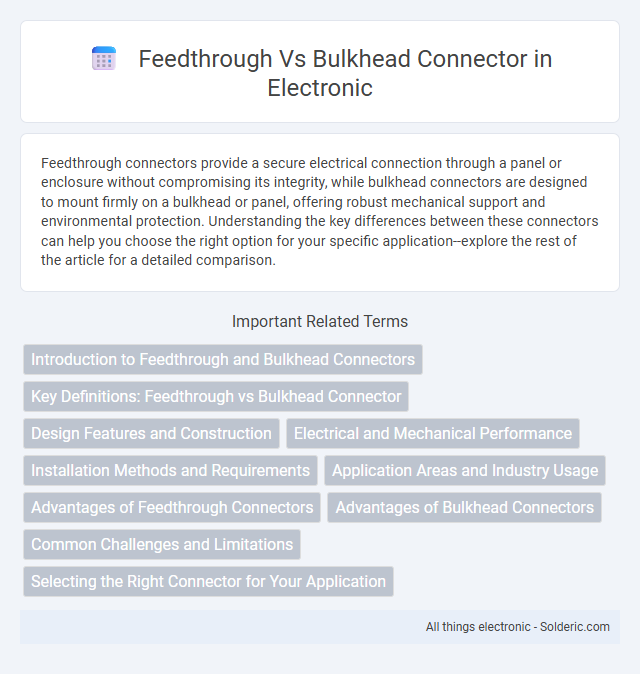Feedthrough connectors provide a secure electrical connection through a panel or enclosure without compromising its integrity, while bulkhead connectors are designed to mount firmly on a bulkhead or panel, offering robust mechanical support and environmental protection. Understanding the key differences between these connectors can help you choose the right option for your specific application--explore the rest of the article for a detailed comparison.
Comparison Table
| Feature | Feedthrough Connector | Bulkhead Connector |
|---|---|---|
| Purpose | Allows electrical signals to pass through a panel or enclosure while maintaining a sealed connection. | Provides a secure connection point mounted on a panel or bulkhead, often used to connect two separate cable sections. |
| Installation | Installed by passing through the enclosure wall; typically soldered or crimped internally. | Mounted on a panel with a nut, offering mechanical stability and easy access from both sides. |
| Sealing | Designed for hermetic or environmental sealing to prevent contaminants. | May or may not be sealed; sealing depends on gasket or O-ring use. |
| Typical Use | High-frequency signal transmission, vacuum or pressure environments. | General cable interconnection, rugged environments requiring mechanical strength. |
| Mechanical Support | Minimal mechanical support; mainly electrical interface. | Provides robust mechanical support for cables and connectors. |
Introduction to Feedthrough and Bulkhead Connectors
Feedthrough and bulkhead connectors are crucial components for ensuring reliable electrical connections in various industrial and electronic applications. A feedthrough connector allows signals or power to pass through an enclosure or panel without compromising its environmental seal, while a bulkhead connector is mounted securely on a panel or bulkhead, providing a stable interface between internal and external wiring. Understanding the differences helps you select the right connector type for maintaining signal integrity and mechanical durability in your system designs.
Key Definitions: Feedthrough vs Bulkhead Connector
A Feedthrough connector is designed to allow electrical signals or power to pass through a panel or enclosure while maintaining a secure, sealed connection, often used for high-frequency or high-voltage applications. A Bulkhead connector, by contrast, is mounted on the enclosure's bulkhead, enabling external devices to connect through a panel with robust mechanical support and environmental protection. Your choice depends on the application's requirements for sealing, mechanical stability, and signal integrity.
Design Features and Construction
Feedthrough connectors feature an insulated center conductor that passes directly through a panel, providing a sealed, low-profile connection ideal for RF and signal transmission with minimal interference. Bulkhead connectors are designed with a robust housing that mounts to a panel, offering enhanced mechanical strength and environmental protection suitable for rugged industrial applications. Your choice depends on whether compact, contamination-resistant design or durability and secure mounting are prioritized.
Electrical and Mechanical Performance
Feedthrough connectors offer superior electrical performance by providing sealed, low-resistance pathways that minimize signal loss and electromagnetic interference, making them ideal for high-frequency applications. Bulkhead connectors excel in mechanical robustness with durable housings designed to withstand environmental stress and mechanical strain, ensuring reliable connections in rugged conditions. Your choice should balance the need for electrical integrity and mechanical strength depending on the application's specific requirements.
Installation Methods and Requirements
Feedthrough connectors typically require panel mounting with precise drilling and sealing to ensure airtight or watertight integrity, often involving soldering or crimping for secure electrical contact. Bulkhead connectors are installed by securing the connector flange to a bulkhead or enclosure wall, demanding appropriate torque on mounting hardware to maintain mechanical stability and environmental protection. Both connector types necessitate careful alignment and compatibility with enclosure materials to ensure optimal performance and durability.
Application Areas and Industry Usage
Feedthrough connectors are widely used in aerospace, medical devices, and telecommunications for their ability to provide hermetic sealing and reliable electrical passage through enclosures. Bulkhead connectors find extensive application in automotive, industrial machinery, and marine industries, where rugged durability and secure panel mounting are critical. Your choice depends on the need for environmental protection versus mechanical robustness within specific operational environments.
Advantages of Feedthrough Connectors
Feedthrough connectors offer compact and efficient sealing capabilities, making them ideal for high-pressure or vacuum environments where maintaining structural integrity is crucial. Their design minimizes signal loss and electromagnetic interference, ensuring reliable data transmission in sensitive applications. You benefit from easier installation and maintenance due to their integrated sealing and connector functions within a single unit.
Advantages of Bulkhead Connectors
Bulkhead connectors provide secure and reliable mounting by allowing cable connections through panels or enclosures, minimizing strain and improving mechanical stability. Their design facilitates easy installation and maintenance, reducing downtime in industrial and electronic applications. Enhanced sealing capabilities of bulkhead connectors protect against dust, moisture, and environmental contaminants, ensuring long-term durability.
Common Challenges and Limitations
Feedthrough and bulkhead connectors often face challenges related to sealing and electrical insulation under harsh environmental conditions, which can compromise signal integrity. Bulkhead connectors may present limitations in space and mounting flexibility, while feedthrough connectors can struggle with ease of maintenance and replacement due to their fixed installation. Ensuring reliable performance requires careful consideration of your application's pressure, temperature, and vibration requirements to select the appropriate connector type.
Selecting the Right Connector for Your Application
Selecting the right connector for your application depends on the mechanical and environmental requirements; feedthrough connectors are ideal for ensuring signal integrity through enclosures while maintaining a sealed barrier. Bulkhead connectors provide robust mounting options with high durability, suitable for applications requiring frequent connection and disconnection on panel walls. Consider factors like sealing performance, ease of installation, and electrical specifications to determine whether a feedthrough or bulkhead connector best matches your design needs.
Feedthrough vs Bulkhead connector Infographic

 solderic.com
solderic.com